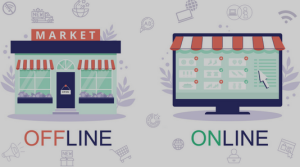The choice between online and offline marketing depends on various factors, including the nature of the business, target audience, marketing goals, budget, and the overall marketing strategy. Both online and offline marketing channels have their advantages and limitations. The purpose of this study is to give a breakdown of some key considerations for marketers’ choice:

Marketers’ Choice: Online or Offline
Table of Contents
ToggleOnline Marketing:
Advantages:
- Global Reach: Online marketing allows businesses to reach a global audience, breaking down geographical barriers.
- Targeting Capabilities: Digital marketing platforms provide advanced targeting options based on demographics, interests, and online behavior.
- Real-Time Analytics: Marketers can track and analyze campaign performance in real-time, enabling quick adjustments and optimization.
- Cost-Effectiveness: Online marketing can be more cost-effective, especially for small businesses, compared to traditional advertising methods.
- Interactivity: Social media, email marketing, and other online channels enable direct interaction with the audience, fostering engagement and relationship building.
- Flexibility: Campaigns can be quickly adjusted, and content can be updated in real-time, providing flexibility in marketing strategies.
Limitations:
- Digital Saturation: With the increasing volume of online content, it can be challenging for businesses to stand out and capture audience attention.
- Technical Barriers: Some target audiences may not have easy access to the internet or may not be comfortable with digital technologies.
- Ad Blockers: The use of ad blockers can limit the visibility of online ads.
Offline Marketing:
Advantages:
- Tangibility: Physical marketing materials, such as brochures and business cards, provide a tangible presence for the brand.
- Local Targeting: Traditional methods like local newspapers, radio, and direct mail can effectively target local audiences.
- Trust Building: Some consumers still perceive traditional marketing channels as more trustworthy and credible.
- Personal Interaction: Events, trade shows, and in-person activities provide opportunities for face-to-face interaction with potential customers.
- Less Digital Noise: In certain markets, offline channels may have less competition, allowing businesses to stand out more easily.
Limitations:
- Limited Reach: Offline marketing is generally more limited in reach compared to online channels, especially in terms of geographic scope.
- Higher Costs: Traditional advertising methods, such as TV and print ads, can be more expensive than digital advertising.
- Limited Analytics: Tracking the effectiveness of offline campaigns can be more challenging, and results may not be as immediately apparent.
- Less Flexibility: Changes to offline campaigns may require more time and resources compared to online campaigns.
Integrated Approach:
Many successful marketing strategies involve an integrated approach, combining both online and offline channels for maximum impact. This is known as omnichannel marketing. Businesses can leverage the strengths of each channel to create a comprehensive and cohesive marketing strategy. For example, a company might use online channels for global reach and analytics while utilizing offline channels for local community engagement and trust-building.
Ultimately, the choice between online and offline marketing depends on the specific goals and characteristics of the business. A well-rounded marketing strategy considers the strengths and weaknesses of both online and offline channels to create a holistic approach that effectively reaches the target audience.
